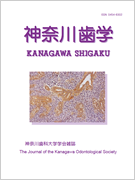- HOME
- > 一般の方
- > バックナンバー:神奈川歯学
- > 58巻2号
- > アブストラクト
アブストラクト(58巻2号:神奈川歯学)

Japanese
| Title : | 上下顎前歯部唇側傾斜を伴う重度骨格性II級上顎前突症に対して歯科矯正用アンカースクリューを使用して非外科的矯正治療を行った症例 |
|---|---|
| Subtitle : | 症例・臨床報告 |
| Authors : | 薄井崇, 小泉創, 山口徹太郎 |
| Authors(kana) : | |
| Organization : | 神奈川歯科大学歯学部歯科矯正学講座歯科矯正学分野 |
| Journal : | 神奈川歯学 |
| Volume : | 58 |
| Number : | 2 |
| Page : | 105-113 |
| Year/Month : | 2023 / 12 |
| Article : | 報告 |
| Publisher : | 神奈川歯科大学学会 |
| Abstract : | 「緒言」矯正歯科治療を行う際には, 骨格の前後的位置を把握することが重要であり, それぞれI級, II級(上顎前突), III級(下顎前突)に分類されている. 小川らは, 矯正歯科に来院した患者数の骨格分布を調査した. 自費診療患者における骨格性II級の患者割合は51.7%で保険診療患者における割合は23%であった. このことからも矯正治療を必要としている骨格性II級患者の数は多く存在する. 骨格性上顎前突の治療は, その程度に応じて治療内容が異なる. 重度の骨格性II級の治療は, 骨切り術を用いた外科的矯正治療が第一選択となる. しかしながら, 外科的治療は, 治療期間の延長, 術中術後の合併症などのリスクや, 手術への恐怖心などの理由から, 患者が手術を受け入れないこともある. このような場合の治療は, 矯正歯科治療単独で行うことになる. 下顎前歯の位置が正常であれば, 上顎小臼歯や大臼歯の片顎抜去によって上顎前突の改善を行う. |
| Practice : | 歯科学 |
| Keywords : | Severe skeletal class II, Non-surgical orthodontic treatment, Orthodontic mini screws, Maxillary molar distalization |
English
| Title : | A case of severe skeletal class II maxillary protrusion with buccal inclination of upper and lower incisor treated with non-surgical orthodontic treatment with orthodontic mini screws |
|---|---|
| Subtitle : | |
| Authors : | Takashi USUI, So KOIZUMI, Tetsutaro YAMAGUCHI |
| Authors(kana) : | |
| Organization : | Department of Orthodontics, School of Dentistry, Kanagawa Dental University |
| Journal : | Kanagawa Shigaku |
| Volume : | 58 |
| Number : | 2 |
| Page : | 105-113 |
| Year/Month : | 2023 / 12 |
| Article : | Report |
| Publisher : | Kanagawa Odontological Society |
| Abstract : | [Abstract] During orthodontic treatment, it is important to understand the appropriate position of the skeletal pattern, which can be classified as Class I, Class II (maxillary protrusion), or Class III (mandibular protrusion). This study reports the successful orthodontic treatment of a 20-years-old female with severe skeletal class II maxillary protrusion with buccal inclination of the upper and lower incisors. The patient desired to avoid surgery; therefore, non-surgical orthodontic treatment was conducted. The maxillary and mandibular first premolars were extracted bilaterally, and orthodontic mini screws and a pre-adjusted edgewise appliance were used. Orthodontic mini screws were applied to distalize the maxillary molars. Computed tomography images were used to plan the implantation of the orthodontic mini screws into the palate as a fixation source, providing greater stability and a lower risk of root injury than implantation into other bones. After 41 months of active treatment, including 10 months of distalization, the upper teeth were successfully distalized and an ideal angle class I occlusion and class I canine relationship were established. Although the amount of movement of the maxillary anterior teeth was significant, no root resorption was observed. Consequently, a class I molar relationship with ideal overjet and overbite, and tight interdigitation were achieved via non-surgical orthodontic treatment. |
| Practice : | Dentistry |
| Keywords : | Severe skeletal class II, Non-surgical orthodontic treatment, Orthodontic mini screws, Maxillary molar distalization |
